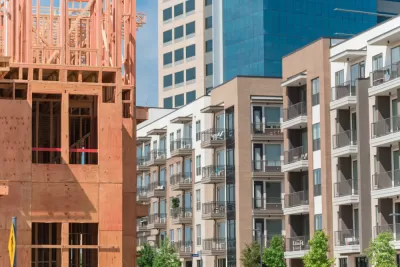Cityscape has published a collection of new research building support for zoning reforms as a tool for mitigating the effects of the housing affordability crisis.

In the past, scientific evidence on the effects of increased housing supply was hard to come by and the findings of the scant body of research often produced contradictory findings.
With every passing year, the number of studies on the subject of zoning reform for housing supply increases. The latest examples comes from Cityscape, a research journal published by the Office of Policy Development and Research (PD&R) of the U.S. Department of Housing and Urban Development. The most recent edition of the journal included a symposium of papers adding a pile of new research on the effects of zoning reforms.
Adam A. Milsap, writing for Forbes, provides explanations of each of these studies, describing the collection as confirmation that “that zoning changes and other land-use reforms can increase the supply of housing, help control prices, and boost local tax bases.” Among the collection, three studies focus on recent zoning reform efforts in California, including legalization of accessory dwelling units and greater enforcement of the Regional Housing Needs Assessment (RHNA) process.
Another study, based on previous research by Nolan Gray, focuses on reforms in Houston that reduced the minimum lot size from 5,000 square feet to as low as 1,400 square feet in some areas. The new study, by Jake Wegmann, Aabiya Noman Baqai, and Josh Conrad, “finds that this minimum lot size reform led to increased development on underused commercial and industrial land and in largely underbuilt middle-income neighborhoods,” according to Milsap.
FULL STORY: New Studies Provide Further Evidence That Zoning Reforms Work

Manufactured Crisis: Losing the Nation’s Largest Source of Unsubsidized Affordable Housing
Manufactured housing communities have long been an affordable housing option for millions of people living in the U.S., but that affordability is disappearing rapidly. How did we get here?

Americans May Be Stuck — But Why?
Americans are moving a lot less than they once did, and that is a problem. While Yoni Applebaum, in his highly-publicized article Stuck, gets the reasons badly wrong, it's still important to ask: why are we moving so much less than before?

Using Old Oil and Gas Wells for Green Energy Storage
Penn State researchers have found that repurposing abandoned oil and gas wells for geothermal-assisted compressed-air energy storage can boost efficiency, reduce environmental risks, and support clean energy and job transitions.

Updating LA’s Tree Rules Could Bring More Shade to Underserved Neighborhoods
A new USC study finds that relaxing Los Angeles’ outdated tree planting guidelines could significantly expand urban tree canopy and reduce shade disparities in lower-income neighborhoods, though infrastructure investments are also needed.

California's Canal Solar Projects Aim to Conserve Resources and Expand Clean Energy
California’s Project Nexus has begun generating electricity from solar panels installed over irrigation canals, with researchers and state agencies exploring statewide expansion to conserve water and boost clean energy production.

HHS Staff Cuts Gut Energy Assistance Program
The full staff of a federal program that distributes heating and cooling assistance for low-income families was laid off, jeopardizing the program’s operations.
Urban Design for Planners 1: Software Tools
This six-course series explores essential urban design concepts using open source software and equips planners with the tools they need to participate fully in the urban design process.
Planning for Universal Design
Learn the tools for implementing Universal Design in planning regulations.
Heyer Gruel & Associates PA
City of Moreno Valley
Institute for Housing and Urban Development Studies (IHS)
City of Grandview
Harvard GSD Executive Education
Salt Lake City
NYU Wagner Graduate School of Public Service
City of Cambridge, Maryland





























